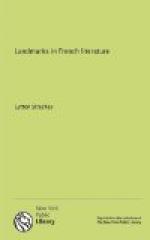Unlike the majority of the writers of his age, La Rochefoucauld was an aristocrat; and this fact gives a peculiar tone to his work. In spite of the great labour which he spent upon perfecting it, he has managed, in some subtle way, to preserve all through it an air of slight disdain. ‘Yes, these sentences are all perfect,’ he seems to be saying; ’but then, what else would you have? Unless one writes perfect sentences, why should one trouble to write?’ In his opinion, ’le vrai honnete homme est celui qui ne se pique de rien’; and it is clear that he followed his own dictum. His attitude was eminently detached. Though what he says reveals so intensely personal a vision, he himself somehow remains impersonal. Beneath the flawless surface of his workmanship, the clever Duke eludes us. We can only see, as we peer into the recesses, an infinite ingenuity and a very bitter love of truth.
A richer art and a broader outlook upon life meet us in the pages of LA BRUYERE. The instrument is still the same—the witty and searching epigram—but it is no longer being played upon a single string. La Bruyere’s style is extremely supple; he throws his apothegms into an infinite variety of moulds, employing a wide and coloured vocabulary, and a complete mastery of the art of rhetorical effect. Among these short reflections he has scattered a great number of somewhat lengthier portraits or character-studies, some altogether imaginary, others founded wholly or in part on well-known persons of the day. It is here that the great qualities of his style show themselves most clearly. Psychologically, these studies are perhaps less valuable than has sometimes been supposed: they are caricatures rather than portraits—records of the idiosyncrasies of humanity rather than of humanity itself. What cannot be doubted for a moment is the supreme art with which they have been composed. The virtuosity of the language—so solid and yet so brilliant, so varied and yet so pure—reminds one of the hard subtlety of a Greek gem. The rhythm is absolutely perfect, and, with its suspensions, its elaborations, its gradual crescendos, its unerring conclusions, seems to carry the sheer beauty of expressiveness to the farthest conceivable point. Take, as one instance out of a multitude, this description of the crank who devotes his existence to the production of tulips—
Vous le voyez plante et qui a pris racine au milieu de ses tulipes et devant la Solitaire: il ouvre de grands yeux, il frotte ses mains, il se baisse, il la voit de plus pres, il ne l’a jamais vue si belle, il a le coeur epanoui de joie: il la quitte pour l’Orientale; de la, il va a la Veuve; il passe au Drap d’or, de celle-ci a l’Agathe, d’ou il revient enfin a la Solitaire, ou il se fixe, ou il se lasse, ou il s’assied, ou il oublie de diner: aussi est-elle nuancee, bordee, huilee a pieces emportees; elle a un beau vase ou un beau calice; il la contemple,




